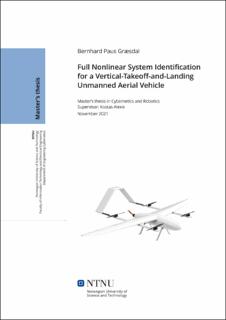| dc.contributor.advisor | Alexis, Kostas | |
| dc.contributor.author | Græsdal, Bernhard Paus | |
| dc.date.accessioned | 2022-02-24T18:19:49Z | |
| dc.date.available | 2022-02-24T18:19:49Z | |
| dc.date.issued | 2021 | |
| dc.identifier | no.ntnu:inspera:76427839:37529044 | |
| dc.identifier.uri | https://hdl.handle.net/11250/2981320 | |
| dc.description.abstract | I denne masteroppgaven presenteres en ny dynamisk modell for den populære VTOL-droneplattformen FoxTech Babyshark 260 VTOL. På grunn av sitt design er fartøyet i stand til å ta av og lande vertikalt, gjennom å kombinere prinsipper fra moderne kvadrotordroner og tradisjonelle fly. For mange bruksområder er det essensielt å ha en god modell av systemet, for eksempel for modellbasert kontroll, planlegging og feildetektering. Ved å tilgjengeliggjøre en dynamisk modell av VTOL-dronen håper forfatteren å fasilitere for fremtidig forskning på VTOL-droner, og å muliggjøre bruk av modellbaserte metoder på fartøyet for både industrielle og akademiske applikasjoner.
Den fullstendige dronemodellen er utledet fra grunnprinsipper i fysikk, og modellparametrene er estimert gjennom optimeringsmetoder fra systemidentifikasjon. 3D-modellering er brukt for å beregne treghetsegenskapene til fartøyet, og separate aktuatormodeller er identifisert gjennom enkle labtester. Flytestdata er innhentet fra ekte eksperimenter, og kinematiske forhold, stykkvise polynomiske funksjoner og analytisk derivering er brukt for å rekonstruere flyets fullstendige tilstand gjennom eksperimentene. Deretter er den aerodynamiske modellen utledet fra flytestdataen, der en stegvis regresjonsprosedyre kombinert med Equation-Error-metoden er brukt for å identifisere en passende modellstruktur for både langsgående og sideveis bevegelse. Videre så er Output-Error-metoden implementert med Gauss-Newton-algoritmen brukt for å finne modellparametrene som minimerer den kvadratiske simuleringsfeilen til modellen. Til slutt er modellen utvidet med en siste parameter for å fange kobling mellom flyets sideror og pitchvinkel, forårsaket av flyets V-hale.
Resultatet av denne oppgaven er en model som beskriver den observerte oppførselen til flyet på en god måte. Tilliten til modellen bygges gjennom residualanalyse på valideringsdata, etterforskning av modellens statiske kurver, individuell parameteranalyse og egenmodusanalyse av den lineariserte modellen for fartøyet. Til slutt så er lovende retninger for fremtidig arbeid foreslått, både for videre utvikling og applikasjoner av modellen. En offentlig tilgjenglig, ferdig implementasjon av modellen finnes på https://github.com/bernhardpg/babyshark_vtol_model. | |
| dc.description.abstract | This thesis presents a novel dynamic model for a widely used Vertical-TakeOff-and-Landing (VTOL) Unmanned Aerial Vehicle (UAV) named the FoxTech Babyshark 260 VTOL. Through its hybrid design, the aircraft is capable of taking off and landing vertically, by combining the principles of fixed-wing and quadcopter aircrafts. Having a good model for the system is crucial for many applications, such as model-based control, planning and fault-detection. Through proposing a publicly available dynamic model of the Babyshark VTOL aircraft, the author hopes to facilitate future research in the field of VTOL UAVs, and to enable the use of model-based methods on the Babyshark for both industrial and academic applications.
The complete UAVmodel is derived from first principles of physics and parameters are estimated with optimization methods through system identification. 3D modeling is used to find the inertial properties of the aircraft, while on-the-ground testing is used to identify separate actuator models. Flight-Test Data (FTD) is obtained from real flight experiments, and kinematic relationships, piecewise splines, and analytical derivation are used for Flight-Path Reconstruction (FPR). The aerodynamic model is then derived from FTD, where a stepwise-regression procedure is used together with the Equation-Error method to identify a suitable aerodynamic model structure for both longitudinal and lateral-directional motion. Next, the Output-Error method is implemented with the Gauss-Newton step optimization algorithm to arrive at the final parameter estimates that minimize the squared simulation error. Finally, a single parameter is added to the model to capture rudder-pitch coupling caused by the aircraft's V-tail configuration.
The result of this thesis is a model which captures the observed behavior of the aircraft well. Confidence in the model is built through residual analysis on validation data, investigation of the static curves of the model, invidividual parameter analysis, and eigenmode analysis of the linearized aircraft model. Finally, future directions are proposed, both for further model development and applications of the model. A ready-to-use implementation of the final model can be found at https://github.com/bernhardpg/babyshark_vtol_model. | |
| dc.language | eng | |
| dc.publisher | NTNU | |
| dc.title | Full Nonlinear System Identification for a Vertical-Takeoff-and-Landing Unmanned Aerial Vehicle | |
| dc.type | Master thesis | |
